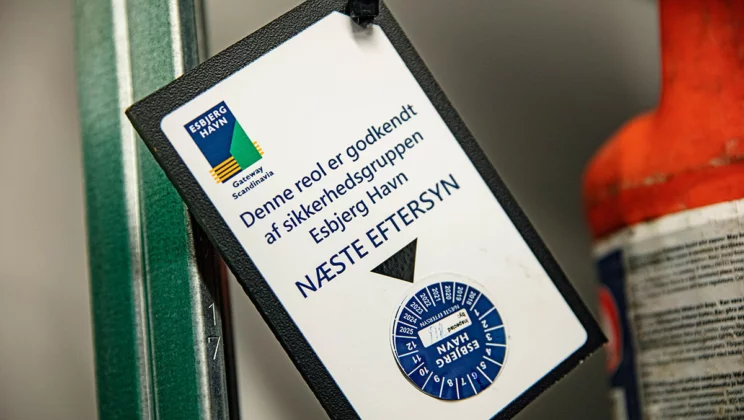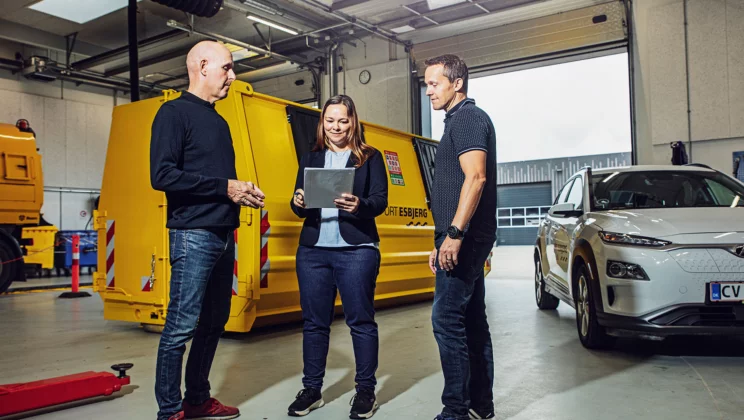Port Esbjerg has just been awarded ISO certifications in central areas, which indicate that the port of Esbjerg is advancing into the European elite of ports. This process was driven by the staff, and the management is now setting new targets.
Every year, some six thousand vessels call at the port of Esbjerg, not counting the Fanø ferries. They generate around 100,000 tonnes of CO2 and consume power while they are docked.
On a daily basis, an average of one thousand lorries drive to and from the harbour with goods. They also have an impact on the climate.
At the same time, the port of Esbjerg is the largest job site in the city. Everyone working at the harbour have a right to feel safe, whatever their job.
Pollution and safety are two areas that the management of Port Esbjerg has been focusing on for quite a few years. Port Esbjerg is aiming for the European elite in its standards for environmental protection and occupational health & safety, supporting its measures with international certifications that document its progress.
Just recently, Port Esbjerg received concrete proof that its efforts have borne fruit:
The company has been awarded three ISO certifications in quality management, environmental management and occupational health & safety.
Port Esbjerg CEO Dennis Jul Pedersen is delighted with the ISO certifications, which were achieved on the back of the sustainability strategy that was implemented just over two years ago. The strategy also included targets for safety, and last year, the objective of becoming carbon neutral was added.
“The ISO certifications provide us with a system to manage our targets, as every month, our KPIs give us an indication how we’re doing within the areas of sustainability, climate, quality and working environment.
One of the KPIs tracks whether we’re driving more kilometres in electric rather than diesel vehicles. We can keep an eye on everything,” explains Jul Pedersen.
Port Esbjerg expects that in 2022, the company will also be awarded the maritime environmental certification, Port Environmental Review System (PERS), which is based on standards established by the European Sea Ports Organisation (ESPO).

The port of Esbjerg is in the elite when it comes to environmental protection and safety.
Safety is paramount
Safety was item number one on the agenda of the ISO project.
“Our top priority is that the seven and a half thousand people working at the port area feel safe day to day and that we’ve got a safety culture based on close collaboration with the companies at the port,” says Jul Pedersen.
As an example of a good process, he refers to an incident when a lorry collided with a forklift on the corner of Taurusvej and Amerikavej. This led to a so-called safety pledge: an agreement to collaborate on increasing safety. The intersection was categorised as a red intersection, that is dangerous, and it has now been modified to prevent further accidents.
The anchor of the ISO project
Some twenty employees work at the service yard in Taurusvej in the eastern section of the harbour, operating cranes and other heavy equipment. This is the type of work where incorrect use of equipment can cause industrial accidents. During her fourteen years with Port Esbjerg, HSEQ Manager Jane Behrens von Qualen has worked in operations in Taurusvej and in the administration office in Hulvej as an engineer. She was an obvious choice as the anchor of the ISO project. Behrens von Qualen believes that the ISO project has sharpened the focus on occupational health & safety:
“There’s an increased awareness of how we can improve safety in our unit,” she says.
Their efforts in this respect have been structured, as all tasks have been described in detail to ensure that they are always performed in the same manner.
“It’s been quite a puzzle getting a handle on all the details, but it’s been one way of highlighting the objective for everybody – that we all return home safely every day,” says Behrens von Qualen.
Incidents and near misses are being recorded, and with the increased awareness of performing every task with safety in mind, the number of reports has increased dramatically from around 15 per year to nearly 200 in the first eight months of this year.

Jane Behrens von Qualen has been leading the ISO-project, which has done a lot for the health & safety at the port.
Our employees are front and centre
Team leaders Glenn Hansen and John Fritsen have noticed that the approach to working systematically with safety generally and more specifically with occupational health & safety has moved on.
When employees arrive in the morning and get their tasks allocated, they hold a toolbox meeting where they run through what they need to pay particular attention to. This might be working with cranes, at heights or near the quayside that pose potential hazards and place particular demands on the safety equipment to be used. The employees then produce a proposal for how they intend to perform the task which Hansen and Fritsen need to approve.
“It gives you peace of mind to know that all tasks are performed according to detailed guidelines and that everything is thought through in advance,” says Hansen.
The operatives at the port have not been careless or foolhardy till now. However, in addition to the hardware and machinery they were used to, they now have a digital tool, the IT program D4.
“The current arrangement is that all operations operatives must spend time at the computer every day. If Martin is to be working the crane, he reads up on the task and reminds himself of what he needs to pay particular attention to in order to stay safe. Not everyone is as IT-minded as we are at the operations office, but it’s so easy to work in D4 that it causes no problems, and if anyone should have any questions, there’s always somebody around to ask,” explains Fritsen.
Visible results
In addition to the employees’ safety, Port Esbjerg’s ISO certifications concern the environment and quality.
The company’s environmental efforts concentrate around handling the waste from the vessels calling at Esbjerg.
“Till now, we’ve not been able to meet the targets we set for ourselves, and waste was registered incorrectly. I’ve recently introduced a dashboard, so employees can follow the results every month. One of the targets was to recycle 25 per cent of the food and industrial waste categories and we’re making concerted efforts to achieve it,” explains Behrens von Qualen.
Port Esbjerg invariably assesses quality in quite a different manner to, say, a factory producing nuts and bolts, which will find it quite easy to monitor product quality.
“We’ve got to measure our quality on whether our customers are satisfied with the infrastructure and service we offer. We need to operate cranes with great precision to complete tasks and collect waste as and when our customers require, and then we generally need to offer cleared and serviceable quays without potholes – and the same goes for relevant access roads,” says Behrens von Qualen.
A proud company
The increased focus on the three central areas of management has also had a beneficial effect organisationally. Hansen emphasises that it has become clearer who is in charge of the various tasks in both the maritime and operations departments. His team leader colleague adds:
“Day to day, we’re busy with our own work, but now we act much more as one unified company, and our colleagues from the administration office also wear helmets, safety shoes and yellow class-3 vests when they are out and about on the quayside. I’m actually quite proud that everyone can now see that ISO certifications aren’t empty accolades. It all makes perfect sense,” says Fritsen.
Shore-to-ship power for large vessels making all the difference
Jul Pedersen notes that Port Esbjerg feels a strong obligation to subscribe to the overall environmental objective of its owner, the Local Authority of Esbjerg, to be carbon neutral by 2030. And preferably a few years earlier.
The company’s efforts involve everything from the major sources of pollution, vessels and lorries, to much smaller sources gleaned at a workshop with input from employees. In the latter category comes a floral display outside the administration office in Hulvej which has been removed to eliminate energy-intensive watering and turf replaced by marram grass on an area by the Fanø ferry terminal to eliminate the requirement of mowing.
Environmental impact on a somewhat larger scale stems from docked vessels, lorries and the port’s own cranes. Particularly the vessels’ environmental footprint varies from one day to the next. The dense short-sea route network in Europe means that CO2 emissions from vessels make up as much as 18 per cent of total European pollution, compared to just three per cent globally.
In collaboration with US technology giant Honeywell, Port Esbjerg has developed a carbon management system that predicts the carbon emissions of every individual vessel calling at Esbjerg. The overview achieved enables the port authority to direct vessels to dock at a quay where one of the port’s nine shore-to-ship power plants has been installed. A further seven or eight shore-to-ship power plants are under way together with a mobile hydrogen refuelling station.
Consuming shore-to-ship power while docked, a vessel cuts in half its expense on electricity compared to using its on-board diesel-fuelled generators. Shore-to-ship power has been available to fishermen landing their catch for a very long time; what is new is that large vessels are now offered the same service. “We’ve no intention making money on supplying power. For us, the driving force is that our customers save money and our initiative benefits the environment,” says Jul Pedersen.
Lorries on climate-friendly routes
The same idea is behind giving hauliers a discount on the freight tax, if they choose a climate-optimal route for the lorries that come to the port of Esbjerg. Here, too, Port Esbjerg has entered into a ground-breaking partnership with a leading international player, the French IT firm Atos, which provides digital solutions to identify routes with the smallest possible climate footprints.
“If, for example, a Polish lorry is on its way to Britain and it may be established with the aid of the IT system that the haulier has selected an optimal route, we want to reward that by issuing a discount on the freight tax,” explains Jul Pedersen.
The company’s initiatives within health & safety and the environment are motivated by idealism, but Port Esbjerg CCO Jesper Bank is not blind to the commercial potential of having a strong profile in these areas.
“We’re very aware that the port of Esbjerg forms part of an international value chain, and to use that in the best way commercially, we’ve got to be at the forefront in terms of certifications and sustainability,” says Bank.
Go to overview

